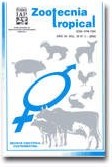
|
Zootecnia Tropical
Instituto Nacional de Investigaciones Agrícolas Venezuela
ISSN: 0798-7269
Vol. 26, No. 4, 2008, pp. 429-437
|
 Bioline Code: zt08079
Bioline Code: zt08079
Full paper language: Spanish
Document type: Research Article
Document available free of charge
|
|
|
Zootecnia Tropical, Vol. 26, No. 4, 2008, pp. 429-437
| es |
Etología de vaquillas doble propósito en un sistema silvopastoril durante el período seco en una sabana tropical
Espinoza, Freddy; Hernández, Rafael Alejo & Folache, Luis
Resumen
Con el objetivo de cuantificar el tiempo dedicado a las actividades realizadas por vaquillas doble propósito en
un sistema silvopastoril durante el período seco, se llevó a cabo un estudio en el municipio San José de Guaribe,
al Nororiente del estado Guárico, Venezuela. Se establecieron tres tratamientos, SP: Pastoreo en pasto estrella
( Cynodon nlemfuensis

), ARB: Pastoreo en pasto estrella con acceso restringido al bosque y LAB: Pastoreo en
pasto estrella con libre acceso al bosque. Se utilizó una presión de pastoreo de 6 kg MS/100 kg PV en función
de la oferta de gramíneas. Se introdujeron siete vaquillas en SP, seis en ARB y 10 en LAB en potreros de 0,5;
0,5 y 3 ha, respectivamente. Se observaron las siguientes actividades por tres días consecutivos: pastoreo, rumia,
hojarasqueo (consumo de hojas caídas secas), ramoneo, descanso, ingesta de agua, excreción fecal y urinaria.
El diseño utilizado fue completamente al azar, donde cada animal representó una réplica (tres/tratamiento). Los
datos fueron analizados a través de estadística descriptiva. La distribución del tiempo de pastoreo tanto en el
día como en la noche, tienden a ser diferentes, siendo mayor para SP (pastoreo en estrella) con un total de
53%; mientras que en ARB y LAB osciló entre 41 y 43%, respectivamente. Los animales tendieron a rumiar
de forma postrada durante las horas nocturnas con un promedio de 20%. Durante el día cuando los animales se
introducen al bosque el hojarasqueo es la actividad más importante (9%). El pastoreo de los animales en SP y
ARB fue durante las primeras horas de la mañana, mientras que en LAB fue el hojarasqueo. Se encontró una
mayor diversidad de ciclos de pastoreo en SP. Se concluye que la introducción o utilización de otros componentes
vegetales consumibles por los animales, además de incrementar la disponibilidad y el consumo de materia seca
durante el período seco, modifica la etología.
Palabras-clave
pastoreo, hojarasqueo, rumia, ramoneo, bosque, vaquillas
|
| |
| en |
Ethology of double purpose heifers in a silvopastoral system during the dry season in a tropical savanna
Espinoza, Freddy; Hernández, Rafael Alejo & Folache, Luis
Abstract
In order to evaluate the behaviour of double purpose heifers in a tropical dry forest during the dry season, it was
carried out a study during the dry season in the municipality of San José de Guaribe at North of Guárico state,
Venezuela. Treatments were G: Grazing of star grass, Cynodon nlemfuensis

, GRA: Grazing of C. nlemfuensis
with restricted access to forest, and GFA: Grazing of C. nlemfuensis with free access to the forest. A grazing
pressure of 6 kg DM/100 kg LW was used. Seven heifers in G, six in GRA, and 10 in GFA were used in paddocks
of 0.5, 0.5 and 3 ha, respectively. The evaluation was made during three days following the activities of the
animals: grazing, ruminating, intake of fallen leaves, water drinking, browsing, resting, defecating, and urinating.
A design of blocks at random was used, where each animal represented a repetition (three/treatment). The data
were analyzed through descriptive statistic. The distribution of the grazing time tended to be different, being
higher for G with a total of 53%; whereas in GRA and GFA it varied between 41 and 43%. Animals tended to ruminate prostrated during the nocturnal hours with average of 20%. During the day when the animals entered to
the forest, the intake of fallen leaves was the most important activity (9%). Grazing of the animals in G and GRA
was around sunrise, whereas in GFA was the intake of fallen leaves. A greater diversity of cycles of grazing was
obtained in G. It is concluded that the introduction or use of other consumable plant components by the animals,
besides to increase the availability and consumption of dry matter during the dry season, modify the ethology.
Keywords
grazing, ruminating, intake of fallen leaves, water drink, browsing, resting, defecating, urinating.
|
| |
© Copyright 2008 - Zootecnia Tropical
Alternative site location: http://www.sian.inia.gob.ve/repositorio/revistas_ci/ZootecniaTropical/ztindice.htm
|
|
